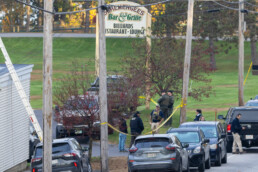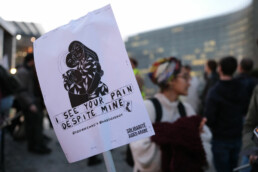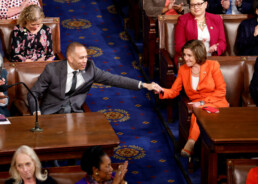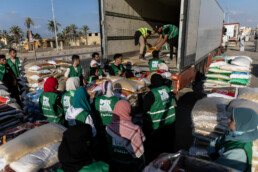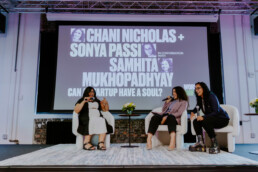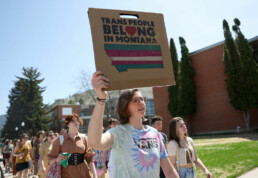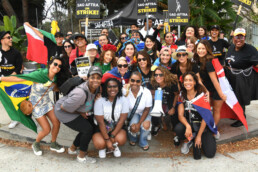A purge in Ohio
|
No images? Click here  October 31, 2023 Happy Halloween, Meteor readers, I’ve never been much of a costume girlie. I prefer Dia de los Muertos, which is celebrated in the days after Halloween. I love the idea of making the veil between the living and those who’ve crossed over a bit thinner. So remember to put out a candle and a little treat for your loved ones or any other spirits you’re welcoming. And if there are some ghosts you’re trying to avoid? Burn a little sage, name the ghost, and say aloud that they aren’t welcome. You can thank me later.  In today’s newsletter, we take a look at GOP tomfoolery in Ohio, the arrest of an Iranian hero, and an engagement announcement. Summoning spirits, Shannon Melero  WHAT'S GOING ONThe Purge: Nearly 27,000 people just lost the ability to vote in Ohio. How does that happen, exactly? It’s routine to maintain the list of registered voters by removing those who change their names or have moved. But in the last decade, since a 2013 Supreme Court case gutted the Voting Rights Act of 1965, irresponsible purges are on the rise—and often come with a political motivation. This Ohio purge is particularly suspect because of its timing and, more to the point, because of what's on the ballot next week. Before they’re removed, voters are required to receive notification about the pending risk. But since those notifications can easily slip under the radar, it’s customary not to carry out a purge so close to an election. The fact that Ohio Secretary of State Frank LaRose scheduled this purge less than a week before Election Day has raised suspicions among his colleagues—especially because, just this August, LaRose delayed a purge until after a special election that included a GOP-backed measure meant to make it tougher to pass constitutional amendments. Which brings us to the heart of the issue: What exactly is LaRose preventing some Ohioans from voting on next week? A few things, but the big fish on the ballot is Issue 1, a measure that would amend the state constitution and “prevent the state from banning access to abortion, contraception, miscarriage care and other reproductive decisions.” LaRose knows the odds are stacked against him. Similar elections putting abortion on the ballot have resulted in a spate of pro-choice victories, even in conservative states like Kansas, Kentucky, and Montana. The GOP is fully aware that the majority of Americans support abortion access, and voter suppression is the only way to get around that inconvenient fact. (For a party that claims to hate government overreach, they’re giving extreme reach.) If Issue 1 does go on to fail by less than 27,000 votes next Tuesday, the purge may have been successful, and LaRose will have laid out a blueprint for other anti-abortion Secretaries of State looking to change the outcome of elections. These kinds of tactics are a reminder of just how much extremists rely on sowing confusion and making voting as difficult as possible. Don’t let them. AND:
 Demonstrators rally outside the U.S. Capitol demanding a cease fire in Gaza on October 18. (Image by Chip Somodevilla via Getty Images)
 WE'RE GIVING AWAY SOMETHING EXTRA SPECIAL THIS MONTH! FOR EVERY FRIEND THAT SIGNS UP FOR THIS NEWSLETTER USING YOUR UNIQUE SHARE CODE BELOW YOU'LL BE ENTERED INTO A DRAWING TO WIN TWO FREE TICKETS TO MEET THE MOMENT AT THE BROOKLYN MUSEUM DON'T HAVE A CODE? GET ONE HERE!  ICYMIDidn’t make it to Work Shift? We’ve got you covered! Enjoy this panel discussion featuring two HR execs who are letting us non-HR folk know what goes on behind the scenes—and how they're putting the “human” back into human resources. SPONSORED BY:  FOLLOW THE METEOR Thank you for reading The Meteor! Got this from a friend?
|
![]()
"Why do people do this?"
|
No images? Click here Good evening, Meteor readers, As we amble our way towards November (it’s RIGHT there), I am thinking of entering a season of gratitude. With the news awash with tragedy—the mass shooting in Maine, the devastation of Hurricane Otis in Acapulco, and the continuing crises in Gaza and Israel—I am more aware than ever of how often I take for granted life’s small pleasant surprises. Let’s all choose to be better about that. In today’s newsletter we look at the inadequate gun laws that made way for the Maine shooting, share our weekend reading, and hear from one of the women who first blew the whistle on AI’s biased ways. With love, Shannon Melero  WHAT'S GOING ON THE BAR WHERE PART OF WEDNESDAY'S MASS SHOOTING TOOK PLACE. (IMAGE BY SCOTT EISEN VIA GETTY IMAGES) Lewiston, Maine: It started in a bowling alley on Wednesday night. Officials say that around 7 p.m., a gunman entered Sparetime Recreation and started firing rounds from an “assault-style weapon.” He eventually fled the scene and drove to a local bar to continue the shooting spree. So far, 18 people have been confirmed dead, with 13 injured. One of the wounded, a 10-year-old named Zoey, who was there with her youth bowling league, told a local news station, “I had never thought I’d grow up and get a bullet in my leg. And it’s just like, why? Why do people do this?” The simplest answer to Zoey’s question is: because they can. The suspected gunman, Robert Card, is a firearms instructor and a U.S. Army Reservist. As early as this summer, military officials had “concerns” about Card, and later reported him for erratic behavior while supporting summer training for cadets at West Point. Card was later admitted to a mental health facility, where he claimed he’d been “hearing voices and threats to shoot up” West Point. Despite all of this, Card still had access to firearms. That’s because in Maine—where gun laws are some of the most obscenely lax in the country—just about anyone can legally acquire a firearm. There are weak background check laws, no waiting periods, and no red flag laws, which prohibit gun purchases or possession for anybody who shows signs of being a threat to themselves or others. (Hearing voices and threats to shoot up West Point would count.) Not only that, Maine has had a “permitless carry law” since 2015. This means that any person over the age of 21 “or at least 18 and active duty or honorably discharged military” who owns a gun can carry “loaded, concealed handguns in public without a permit or background checks.” It should not take a mass shooting to enact the most basic gun safety laws. It’s too late for the 18 victims and their families, but it isn’t too late for Zoey, or the rest of us. You can learn more about safety initiatives in Maine from The Maine Gun Safety Coalition and check the laws in your state at Everytown for Gun Safety. AND:
 “The Past Dwells in our Datasets”Can AI ever be unbiased? MIT scholar Dr. Joy Buolamwini has some answersBY REBECCA CARROLL  (IMAGE BY PARAS GRIFFIN VIA GETTY IMAGES) In the celebrated Steven Spielberg movie A.I., set in the 22nd century, scientists create an android boy capable of experiencing human emotions. The film (and its all-white cast) try hard to convince us that at its best, artificial intelligence can learn to love. That was 2001. More than 20 years later, we’re discovering that AI—which now mostly takes the form of computer programs rather than robots—often actually reflects real people’s worst biases. And those embedded prejudices are doing a lot of harm, argues computer scientist, digital activist, and “poet of code” Dr. Joy Buolamwini in her new book, Unmasking AI: My Mission to Protect What is Human in the World. Born in Edmonton, Canada, Dr. Buolamwini spent her early years in Ghana before moving with her artist mother and scientist father to Mississippi when she was four. Just five years later, she saw an MIT-made robot called Kismet on a PBS science program—and decided on the spot that she was going to attend MIT to study robotics. But, once at MIT, she quickly realized her calling was much bigger. As she learned about the ways racial, gender and ableist biases had crept into facial recognition technology, she launched the Algorithmic Justice League, an organization that uses art and policy to advocate for equitable AI systems. I talked to Dr. Buolamwini about not just the harm but the potential of AI. Rebecca Carroll: You write that AI developers promise that AI will “overcome human limitations”—what does that mean exactly? Dr. Joy Buolamwini: AI is presented as enabling humans to be more efficient, more productive, and help overcome human limitations. For example, some AI tools for hiring have been presented as an alternative to human decision-makers who we know can be biased. The problem is AI tools are often created with datasets that reflect past decisions. So AI tools trained on past hiring decisions will reflect the preference and prejudice of the past and make them into current technologies. Amazon found this out when it attempted to make a hiring tool that was shown to discriminate against women. They ended up getting rid of the tool because even after they tried to address the bias, it still favored men. I think it is easy to assume technology will be more neutral than human because technical systems are mathematically based, but it is important to remember that the past dwells in our datasets. You talk in the book about the “arbiters of ground truth”—the idea that data or statistics offered through empirical evidence is the only real truth. How does AI complicate that view? The more I do work on AI, the more I see the importance of storytelling. [One’s] lived experience matters. As a graduate student, I was reading about so many AI advances, yet I found myself coding in a white mask to have a computer see my face. I recorded that experience as something I call a counter-demo. Like a counter-narrative, a counter-demo captures an experience that challenges master narratives of who or what is considered normal or worthy, and in this case master narratives about technological advances. My spoken word poem, “AI, Ain’t I a Woman?”, which is also a test of various AI systems, contains many counter-demos of tech companies failing [to identify] the faces of iconic women of color. It challenges the narrative of tech superiority when we see AI failing [to recognize] the faces of Oprah Winfrey, Michele Obama, Serena Williams, and more. I smiled when I read about your first meeting with Timnit Gebru, where you noted that you both wore your hair natural—itself the subject of centuries-long racial profiling and discrimination. Are there specific policies you’re seeking to put into place to help fight against “the coded gaze”? I dropped a few hair references throughout the book, and I am so glad you noticed! I think governments around the world can learn from the EU AI act, which puts a specific ban on the live use of facial recognition technologies in public places. We can also stop police from using facial recognition for investigative leads, as this dangerous use of AI has already led to false arrests, including the arrest of Porcha Woodruff. AI-powered facial recognition misidentification led to her false arrest for carjacking by the Detroit police department. She was eight months pregnant sitting in a holding cell and having contractions. Three years before Porcha’s arrest, Robert Williams was falsely arrested for theft in front of his two young daughters by the same Detroit police department. Despite ample evidence of racial bias in facial recognition technologies, we still live in a world where preventable AI discrimination is allowed. The excoded (those harmed by AI) include even more people falsely arrested due to AI, like Michael Oliver, Nijeer Parks, Randal Reid, and others whose names may never make headlines, but whose lives matter all the same. You call yourself “the poet of code”—is that a nod to the fact that you are, as you share in the book, the daughter of art and science? Absolutely. Growing up, I saw art and science as companions just like my parents. I also see the role of a poet as showing us perspectives that may be marginalized, ignored, or largely unseen. In my poetic work with evocative audits, I use the spoken and written word to humanize AI harms. Poetry takes me to places research papers cannot go. When you were at MIT, you took a class with the Harvard professor Karen Brennan, who posed the question to you and the other students: “What will you do with your privilege?” How would you answer that same question today? I answer it by using my platform to give voice to feelings and perspectives that might otherwise be suppressed. Here is a recent poem I wrote called Angels Awake, on recent man-made and natural disasters: Heart aching, tears breaking, cycles of pain continue. Spine snapped; hope broke... The earth trembling too. Geography and circumstance shaping the fate of precious souls. Today, I walked through beautiful gardens and sat in chairs of opportunity. My life blossoming as the petals of others fade. How can I not be compelled to use every privilege given to offer healing to deepening wounds? Yet, where do we start when the tsunami of history overwhelms? Seismic shifts are centuries in the making. As the night carries on, I remain awake and agitated, grateful to at least be alive to take another breath… A gift lost by many others far too soon. The aftershocks are coming. Where be our better angels now? This interview has been slightly edited and condensed for clarity.  Rebecca Carroll is a writer, cultural critic, and podcast creator/host. Her writing has been published widely, and she is the author of several books, including her recent memoir, Surviving the White Gaze. Rebecca is Editor at Large for The Meteor.  WEEKEND READS 📚On the river and the sea: A slogan of Palestinian freedom is once again under fire for potentially being antisemitic despite many, including this scholar in 2018, explaining its origins. (Forward) On romance: Who would have thought the savior of Bachelor Nation would be this guy? (Vulture) On TV: Not in the mood to read? It happens. The HBO documentary No Accident, which follows a lawsuit brought by those injured while counter-protesting the 2017 “Unite the Right” rally in Charlottesville, is both riveting and informative.  FOLLOW THE METEOR Thank you for reading The Meteor! Got this from a friend? Subscribe using their unique share code or sign up for your own copy, sent Tuesdays and Thursdays.
|
![]()
Learning from post-9/11 America
|
Dear Meteor readers, Have you looked at the foliage lately? In my continuing effort to force everyone to take a moment for their mental health, I want to remind you that trees are great. Here are my favorite ones:  A SECTION OF WOODS I FREQUENT TO DO PRIMAL SCREAMING. In today’s newsletter, we take a look at the ways in which we are and aren’t allowed to talk about Palestine and Israel, marvel at the work of Icelandic people, and share some fun listening. Tree huggin’, Shannon Melero  WHAT'S GOING ONSilent or silenced?: It’s been less than three weeks since Hamas’s deadly attack on Israeli civilians, which set off what has now turned into what UN human-rights experts have described as “crimes against humanity” in Gaza. The situation on the ground is devastating, and has triggered a crisis in the public conversation—a space that has long restricted how to talk about Israel and Palestine. And we’re already seeing what happens to those who choose to speak out about the crisis in Gaza. Yesterday, Michael Eisen was fired from his job as editor-in-chief of biomedical journal eLife after retweeting a headline from The Onion that read, “Dying Gazans Criticized For Not Using Dying Breaths To Condemn Hamas.” Eisen, a Jewish man with family in Israel, tweeted that he admired The Onion’s recognition of the imbalanced attention to the lives of Israeli and Palestinian victims. After much criticism, he wrote a follow-up tweet adding that he was horrified both by what Hamas did and the collective punishment of Gazans. Nonetheless, he’s now unemployed. This isn’t an isolated incident. Maha Dakhil, a talent agent at CAA, was forced to leave her leadership roles after she reshared an Instagram story that read in part, “What’s more heartbreaking than witnessing genocide? Witnessing the denial that genocide is happening.” Yesterday, 92NY, a storied Jewish cultural center in New York City, halted its prestigious literary series after the public outcry about their decision to cancel a reading by Pulitzer Prize-winning novelist Viet Thanh Nguyen because of his criticism of Israel’s military action in Gaza. “I hope there is a moral consensus that killing civilians is wrong, whether Hamas does it or whether Israel does it,” he wrote on Instagram. If all of this sounds eerily familiar, then congratulations, you’ve lived long enough to remember what it was like in the weeks after 9/11. Then as now, Americans were compelled to take a stance: Either you were for revenge at any cost, or you were against America. Even as a sixth grader, I was so influenced by pro-war propaganda that I started to believe Muslims were scary warmongers trying to kill my mom, who worked in the sure-to-be-targeted Chrysler building. (Allah laughed hysterically when I converted to Islam some years later.) Such limited, binary thinking wasn’t just for sixth-graders, alas. Politicians, news outlets, and religious leaders demanded patriotism and support for the wars through strategic censorship and pressure. People who spoke out too early against the U.S.’s military response were swiftly condemned. Susan Sontag was labeled an “America-hater,” a “moral idiot,” and a “traitor” for pointing out America’s actions before the attacks in a brief essay in the New Yorker. Rep. Barbara Lee, who had the courage and the foresight to be the only member of Congress to vote against invading Afghanistan, received death threats and hate mail in response. On the day she cast her vote, she quoted a preacher who spoke at the National Cathedral three days after 9/11: “Let us also pray for divine wisdom…that as we act we not become the evil we deplore.” Twenty years later, the majority of the country agreed with her. Now, as a humanitarian crisis plays out before our eyes, we must look at it through the hard-earned lens of hindsight. As we all figure out how to publicly react and privately debate, we should take with us the words of Sontag in that prescient New Yorker piece: “Let’s by all means grieve together. But let’s not be stupid together. A few shreds of historical awareness might help us understand what has just happened, and what may continue to happen.” AND:
 VOLUME ON HIGH 🎧

 FOLLOW THE METEOR Thank you for reading The Meteor! Subscribe using their unique share code or snag your own copy, sent Tuesdays and Thursdays.
|
![]()
Remember when we had a House Speaker?
|
Hey Meteor readers, A core practice of my faith is something my mom calls “standing in the pit.” It’s the idea that if someone close to you is suffering, you must stand beside them in that moment. This week, I was in the pit with a dear friend and Palestinian activist who was berating herself for not carrying out her normal duties. “I haven't cooked dinner for my family,” she texted me. I offer you the same advice I offered her: It is okay to stop for a moment and take care of yourself. Simply sitting alone for five minutes, or even using the bathroom without your phone, can make a difference. You deserve that time. In today’s newsletter, we check in on what’s happening in the House, discover a frightening new domestic violence statistic, and share what we’ve been watching to quiet our minds. In the pit beside you, Shannon Melero  WHAT'S GOING ONI bet you think about me (Nancy Pelosi’s version): The House of Representatives has now gone more than two weeks without a speaker, and it’s unclear at this point who will muster enough votes for the job. What is becoming clear is how much Nancy Pelosi’s coworkers miss serving under her—even the ones from across the aisle. In the wake of Rep. Kevin McCarthy’s ouster, Republican Rep. Tim Burchett told The Daily, “I catch a lot of hell for saying this, but she was an effective leader.” Rep. Pelosi, for her part, isn’t mincing words: “I feel sad for the institution,” she told reporters after Rep. Jim Jordan’s first failed vote. “I think it’s sad that they’re getting worse and worse.” While the House chaos might seem like a petty Washington squabble, we’re actually in the middle of a historic moment. This is the longest the House has ever been speakerless, and it couldn't be happening at a more inconvenient time. Without a speaker, the House is unable to vote on any legislation or funding measures—like this hospital pricing bill that was ready to be brought to the floor the same week McCarthy was voted out. It’s not the same: While the House twiddled its thumbs this week, protesters with Jewish Voices for Peace and IfNotNow were staging a sit-in at the Capitol calling for a ceasefire in Gaza. Standing with the protesters was Rep. Rashida Tlaib, who told the crowd that most Americans “are against occupation. They are against human rights violations. If you just tell them the truth, they will be on our side. So we have to speak the truth.” The gathering was immediately mischaracterized by Rep. Marjorie Taylor Greene, who called it an “insurrection.” (Point of clarity: They weren’t armed. And no one was threatening to hang the vice president.) But it wasn’t just conservatives who took aim at the activists. A statement released by the Anti-Defamation League labeled the protesters as “far-left radical organizations” and “anti-Zionists,” adding, “Let’s be clear: Anti-Zionism is antisemitism.” So let’s go over this one more time! A protest is not the same as an insurrection (MTG, of all people, would know). Anti-Zionism is not the same as antisemitism. And anti-Zionists are only a part of a huge, diverse coalition calling for ceasefire around the world. I know we’re all capable of understanding the difference between calling a government to account for its atrocities and hating a single ethno-religious group. Pretending that we’re not is an affront to people honoring complexities while finding moral clarity. AND:
|
|
You are receiving this email because you have subscribed to our newsletter. |
![]()
An escalating humanitarian crisis
|
Beloved Meteor readers, It’s been hard to breathe these last few days. Like many of us, I’m struggling to carry on a normal day knowing there are people digging children out of rubble or wondering if their relatives taken hostage are alive. Over the weekend, I went into the woods in search of mental and literal silence, only to return to the news that a six-year-old boy in Chicago had been killed in his home in what investigators are calling an anti-Palestinian, Islamophobic attack. And I wept, not only for him and his mother but for the countless children who will inherit this world of violence. In today’s newsletter, we try to answer a question many have had over the last few days: How can we help? (It’s not simple.) And we bring you updates from the rest of the world. Clinging to hope, Shannon Melero  WHAT'S GOING ONUnable to cross: The humanitarian crisis in Gaza is getting worse. As a result of Israel cutting off all utilities in the Gaza Strip in the wake of Hamas’s deadly attacks 10 days ago, the region is running out of clean water, food is scarce, and hospitals are overflowing. (Not to mention the 50,000 women who are pregnant in Gaza right now.) Today the UN issued a statement pleading for “safe passage for desperately needed humanitarian supplies to Gaza.” So where is the aid? There are more than 100 trucks sitting at the border between Gaza and Egypt carrying medical supplies, food, and other vital needs for people just a few yards away. But because the Israeli government has barred any aid from entering Gaza, those trucks cannot move. Were the Egyptian government to allow the trucks passage, the move would be received by Israeli Prime Minister Netanyahu as a move against his government. It would also open the door for Palestinian refugees, which Egypt has said it will not accept. But the Israeli and Egyptian governments are up against the will of the people. Calls for humanitarian aid have transcended religious and ethnic lines, with Jewish groups demanding action with the same fervor as their Muslim counterparts. As Michelle Goldberg wrote in the New York Times, Jews throughout the diaspora are feeling a “moment of great fear and vulnerability…. Nevertheless, as atrocities are piled on atrocities, I hope Jews will attend to what is being threatened in our name. And all Americans should pay attention, given how much our country underwrites Israel’s military.” What can you do? There are two paths forward. The first is, if you’re able to, continue donating to groups such as Doctors Without Borders, the UNCERF, Anera, Islamic Relief, or the Palestine Children’s Relief Fund. Money for these groups helps ensure that Gazans will get medicine, shelter, and food once safe passage is available. Which brings us to the second thing you can do. Call your representatives, call their assistants—scream it in the streets if you have to—and demand that they pressure President Biden into living up to his word to pressure Israel to open the borders to humanitarian aid. The United States owes it to Palestinians to change course now rather than continue to aid our “ally” in carrying out a genocide. AND:
MORE FROM OUR COLLECTIVE MEMBERS ON ISRAEL AND PALESTINESarah Jones on being mixed-race and Jewish, and how the U.S. was founded on stolen land. Mona Chalabi on the biases about who deserves justice (with a little help from ChatGPT). Liz Plank on how “people get killed by war but also get used by it.”  FOLLOW THE METEOR Thank you for reading The Meteor! Subscribe using their unique share code or snag your own copy, sent Tuesdays and Thursdays.
|
![]()
Can a start-up have a soul?
 Greetings, Meteor readers, I wish I could kick this off with something quippy, but it’s been a difficult week for all of us. Six days ago, Hamas carried out an attack on Israel—killing more than 1,000 civilians and taking hundreds hostage. Friday morning, Israel issued a warning to Palestinians in the northern half of Gaza, advising them to evacuate within 24 hours, a move the UN called “impossible”; the very same day AP News reported that Israeli airstrikes had killed Palestinians who were fleeing the region, children among them. The situation has also had reverberations across the U.S. and Europe as anti-semitism is on the rise. But Friday also offered a moment of collective pause. For Muslims, it is a day of communal prayer and for Jews, the beginning of the Sabbath. Finding the small things that unify us—those tiny windows of peace—is so important in an uncertain time. Know that if you’re reading this and you’re in pain, you are not alone. As one of the good books reminds us, “verily with hardship comes ease.” In today’s newsletter, a change of pace—what we learned from the wise speakers at Work Shift—and some weekend reads to keep you informed. In prayer, Shannon Melero  THIS WEEK AT THE METEOROn Thursday afternoon in New York City, we got to leave work to discuss work—gathering with workplace leaders and changemakers at The Meteor’s first Work Shift event. Some of my personal favorite moments:
 PHOTO BY MONNELLE BRITT More exclusive highlights to come from us next week—and if you were there send us an email with your favorite moments at [email protected] and we’ll share your takeaways. WEEKEND READS 📚On mothering through war: Two women from opposite sides of a border share their suffering. One reflects on her son being captured by Hamas, the other explains what’s like to raise children in Gaza. (The New York Times & Rampant Magazine) On Hamas: Isaac Chotiner talks to an expert about the group’s origins and the paradigm shift its attack has created. (The New Yorker) On history repeating itself: For some, the last few days have felt like the heydays of the early post-9/11 era. (n+1) On the X of it all: Twitter was once a vital location for minute-by-minute updates in conflict areas. But Elon Musk’s X is something far less useful. (Slate) On loneliness: One Jewish writer shares his feelings of abandonment from his leftist community in the wake of the Hamas attacks. (The Atlantic)  FOLLOW THE METEOR Thank you for reading The Meteor! Subscribe using their unique share code or snag your own copy, sent Tuesdays and Thursdays.
|
![]()
In war, women and children pay the price
|
Good evening, Meteor readers, Over the last few days, the world has held its breath as we’ve witnessed new levels of violence and destruction in Palestine and Israel. Decades of turmoil, resistance, and failed peace efforts have come to a boiling point. The situation is apocalyptic for the innocent civilians in both Israel and Gaza, where the Israeli government has ordered a complete siege. And for diaspora Palestinians and the global Jewish and Muslim communities, it has been doubly difficult. Not only are they being asked to choose a side in one of the longest-running conflicts in human history, but, on social media, there’s also the pressure to do so in a way that is digestible to everyone else—often without context and nuance. What is happening cannot fit in an easy tweet or cleverly worded Instagram post. Honestly, it can’t even fit in this newsletter. So tonight, we invite everyone to slow down for a moment. Give yourself room to learn, to grieve, to step away from your screens if that works for you. And we also ask our community to be vigilant in a moment when the internet is awash with even more propaganda and misinformation than usual. In today’s newsletter, our team (composed of people with differing views and backgrounds) shares some learnings that have been useful to us—about what’s happening, why it’s happening, and what it will mean for women and girls. Know that we are with you. In mourning, Your Newsletter Team  WHAT'S HAPPENING NOW
HISTORY AND CONTEXT
WOMEN IN WAR ZONES
 FOLLOW THE METEOR Thank you for reading The Meteor! Subscribe using their unique share code or snag your own copy, sent Tuesdays and Thursdays.
|
![]()
From pro-choice TikTok to campaign trail
NEWS
Allie Phillips went viral with her abortion story. Now she’s running for office.
OCTOBER 5, 2023
BY NONA WILLIS ARONOWITZ
If you’d asked Allie Phillips last year whether she’d consider running for office, she would have given you a quick “no.” But that was before a series of events gave her a front-row seat to just how little Republican politicians understand about women’s lives. Back in March, the 28-year-old Tennessee mom and home daycare worker had gone viral on TikTok for sharing her gut-wrenching abortion experience: At her routine 19-week anatomy scan, she’d found out that her daughter, whom she’d already named Miley Rose, had severe fetal anomalies and would not survive outside the womb. Her doctors told Phillips that continuing the pregnancy would put her at risk, but because of Tennessee’s strict abortion ban, they couldn’t help her. She’d have to find another way.
By the time she’d raised thousands of dollars for out-of-state travel and arrived at a New York City clinic for her abortion, she got the heartbreaking news that she’d already lost the baby. Being forced to confront that reality alone in an unfamiliar place with doctors she’d never met made her feel like a “piece of dirt underneath someone’s shoe,” she tells The Meteor. It was “completely inhumane.”
She quickly became not only a passionate pro-choice advocate online and a plaintiff in the Center for Reproductive Rights’ ongoing lawsuit against Tennessee, but also a magnet for other people’s stories. She thought she didn’t know anyone who’d had an abortion, but after sharing her experience, many of her friends and “very immediate family members” told her they’d had the procedure, too. She’d lived in Tennessee since she was six months old; most of the people around her were deeply conservative. “Abortion is a naughty word down here,” she says.
@.allie.phillips I hope my story can make a difference with these laws..😔 #mileyrose #highriskpregnancy #fetaldevelopment #nonviablepregnancy #holoprosencephaly #birthdefects #pregnancyloss #pregnancylosssupport #braindefect #abortioncare #abortionban #tnabortionban #abortionrights #healthcareforwomen #infantloss #fetalcremation ♬ Oceans Hillsong United – gospelreells
Which is why, when her friend set up a meeting with her representative, House Republican Jeff Burkhart, she had a feeling it would be like talking to a brick wall. But his lack both of sympathy and of basic reproductive knowledge still shocked her. He told Phillips, she recalls, that if his daughter had been faced with the same terrible news, he’d tell her to continue her pregnancy, even if doing so would endanger her life. When Phillips mentioned she had a six-year-old daughter, she says he cut her off mid-sentence and said he thought miscarriages could only happen with first pregnancies. “You didn’t think to do an ounce of research, and you’re voting on women’s reproductive health?” Phillips remembers responding aloud. “Are you serious?”
That night, her mom suggested she run for office. Over the next few months, several more people suggested the same. And eventually, Phillips knew what she had to do: She’d run to unseat Rep. Burkhart for Tennessee’s District 75.
Phillips is one of many women whose abortion stories have transformed them into full-throated pro-choice activists since Roe v. Wade fell—and she might be the first of a new wave of candidates, too. Sharing their stories have led some of these women to have close encounters with politicians, exposing how little they actually know about abortion and pregnancy.
Nancy Davis, a woman who was denied an abortion in Louisiana shortly after Roe was overturned and who later established a foundation to help other patients, had a similar wake-up call in the company of legislators. Earlier this year, she testified at a hearing on Louisiana’s ill-fated HB522, which would have prevented doctors from being prosecuted for providing abortions. “Seeing the lack of empathy that was shown to other women and other families, it really had me outraged,” Davis says. After she testified, a male legislator stood up and said his wife had been faced with the same decision but decided to continue the pregnancy. “And I was thinking, ‘You guys still had the right to do what was best for you and your family,’” Davis says. “The bottom line was, he still had that option.”
Like Phillips, Davis realized the most direct way she could confront ignorant policymakers was by voting them out—and possibly replacing them. Davis had a three-hour phone conversation with Phillips recently that inspired her even more. “I just think what she’s doing is amazing,” Davis says. By running for office, Phillips will “motivate other women to do the same thing.” In fact, Davis is hoping to be one of them: “I do plan on running for something [next] year,” she tells The Meteor. It’s the first time she’s revealed this decision publicly.
It’s a well-worn pattern when it comes to closing the gender gap in politics: As women encourage each other, Phillips’ decision to run may prove to have a domino effect. “I told [Davis] the time is now,” she says. “We have got to let these Republican men know that women are powerful, we’re pissed, and we’re coming.”
GOP accidentally helps trans kids
 Hey, Meteor readers, Yesterday, I stayed up quite late (9:30 pm) watching the 45th season premiere of Survivor, and my body hasn’t quite recovered from listening to Emily talk her way into the Crappiest Player Hall of Fame. But it’s always worth it to see Jeff Probst, who is aging like fine Italian wine. Drop the skincare routine, Probst!  In today’s newsletter, we explain what led to an unexpected win in Montana, confront the “childcare cliff,” and share some weekend reading. Calling it an early night, Shannon Melero  WHAT'S GOING ONHorse dewormers for trans rights (somehow): Yesterday morning, a Montana judge blocked SB99, the state’s ban on gender-affirming care for transgender youth—the same ban that State Representative Zooey Zephyr spoke out against last spring, leading to her censure and removal from the House floor. Many parties can be thanked for this win, among them the relentless Zephyr and the Montana citizens who showed up in force to testify against the bill. But one factor might surprise you: Republicans’ fondness for using ivermectin, a horse dewormer, to treat COVID-19. In the same session that saw SB99 become law, Montana Republicans also passed SB422, protecting people’s “right to try” experimental medication not approved by the FDA (such as ivermectin) as long as they—or, if they’re a minor, their parent/legal guardian—have given informed consent. Now listen: Is using ivermectin to treat COVID-19 safe? Survey says no. But in the interest of bodily autonomy, and as someone who’s been receiving gender-affirming medical care for some time now, I’m all for a “you do yours, I’ll do mine” policy when it comes to what we choose to put in our bodies. So why, for these legislators, does informed consent and the “right to try” medication apply to one drug but not another? Zephyr noted this glaring hypocrisy back when SB422 was first introduced. Thankfully, the court agreed: Missoula County District Judge Jason Marks, who was appointed by a Democratic governor, wrote in his decision yesterday that these two laws together allow parents to give consent for their child’s medical treatments “regardless of efficacy or risk…unless the minor is transgender.” He ended up concluding the same thing Zephyr did: that “the purported purpose given for SB99 is disingenuous.” Right wing legislators’ cherry-picking embrace of bodily autonomy is well-documented; they love it when it comes to the right to refuse vaccines or wearing masks, but hate it when it comes to any right exercised by trans or pregnant people. So it’s a real treat to see that, for once, the courts aren’t buying it. —Bailey Wayne Hundl AND:
 JUST CLICK THE LINK ABOVE TO GET YOUR UNIQUE SHARE CODE TO SEND TO FRIENDS. IF FIVE OF THEM SIGN UP, WE'LL SEND YOU A METEOR TOTE! ALREADY HAVE A CODE BUT CAN'T FIND IT? WE'VE GOT YOU COVERED.
 WEEKEND READS 📚On censorship: In America, most book bans are driven by a group of 11 people. Jennifer Petersen, a Virginia mom, is one of them. She has already challenged 73 books—and she has no plans to stop. (The Washington Post) On gender politics: Women and children who fled Afghanistan have been denied entry to the United States in astounding numbers. One family tells their story. (Slate) On the floor: Get ready for the literal Olympics of breakdancing. (The Athletic)  FOLLOW THE METEOR Thank you for reading The Meteor! Subscribe using their unique share code or snag your own copy, sent Tuesdays and Thursdays.
|
![]()
Half of organized workers are women
 September 26, 2023 Hey there, Meteor readers, Many, many people in my life have inquired and I want to confirm to all of them—and you—that yes, I did see that Taylor Swift was at Sunday’s Kansas City Chiefs game. Allegedly Taylor is dating tight end Travis Kelce, but if you ask me, a certified Swiftologist, I’d say this is all part of a larger riddle connected to the re-release of her next album and not an actual romantic relationship. The signs are there if we just connect the dots…  Today’s newsletter is sunnier than normal: We tick off labor’s recent wins, celebrate Carson Pickett’s history-making moment, and share a little good news. Yours in Swiftness, Shannon Melero  WHAT'S GOING ONBigger than Hollywood: There’s light at the end of the tunnel for WGA workers! While SAG-AFTRA is still on strike, the writer’s union reached a tentative agreement with the Alliance of Motion Picture and Television Producers on Sunday after a 146-day strike. (The WGA’s board and members are set to vote on the terms today.) The agreement comes on the heels of another, less publicized victory: a WGA-backed California law that was recently passed in the state’s senate. The bill would allow striking workers to collect unemployment benefits—a pro-labor law that exists in only two other states: New York and New Jersey. If you ask us, this is a Big Deal. Gov. Gavin Newson has yet to sign the bill, but its success and timing is just the latest example of labor’s growing power. Organized labor has been flexing its muscle all over the place lately, and not just in Hollywood: President Biden joined the auto worker’s picket line today in Michigan, UPS workers won a favorable five-year contract in August after they threatened a work stoppage, and American Airlines’ flight attendants recently voted to authorize a strike. Even though the share of workers who are unionized continues to shrink, there’s still an unmistakable pro-labor energy sweeping the country. As Sarita Gupta (who oversees the Future of Work(ers) program at the Ford Foundation) remarked last week at the Free Future summit, “We’re just seeing workers across the economy organize in ways that, at least in my lifetime, I have not experienced.” Let’s be real: The president wouldn’t join a strike unless he knows it’s politically popular. And it’s popular with—and important for—women. When someone mentions “union,” many will think of dudes in hard hats, the kinds of manual laborers that Biden joined today. But that stereotype is inaccurate, both now and throughout history. Nearly half of today’s organized workers are women, and Black workers are more likely to be represented by unions than members of any other racial group. The labor movement is increasingly making headway in industries that are more likely to hire women and people of color, from retail to Amazon warehouses. These are “the exact workers that common wisdom or whatever has told us are not organizable,” labor journalist Kim Kelly told The Meteor last spring. “They are organizing, and they’re winning.” AND:
 TELL ME SOMETHIN' GOOD 🎶
 FOLLOW THE METEOR Thank you for reading The Meteor! Got this from a friend? Subscribe using their unique share code or snag your own copy, sent Tuesdays and Thursdays.
|
![]()



